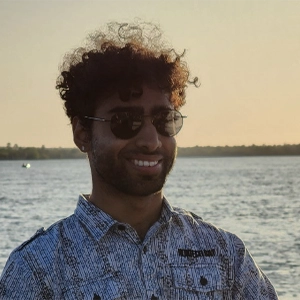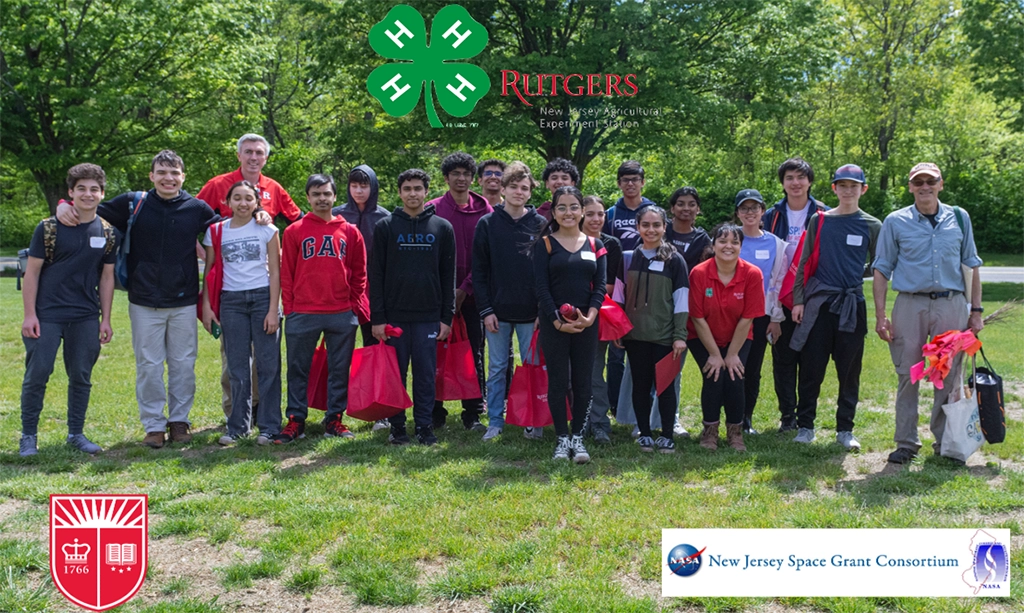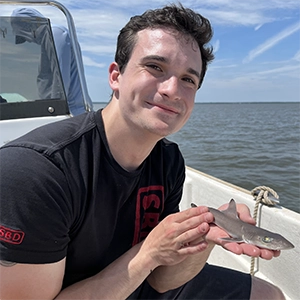Short Bio Towards the end of my undergraduate program in Mechanical Engineering, I had two options: either go into industry or continue with academia. Naturally, I would have picked the industry route, but I didn’t know where exactly that would take me because I didn’t feel any drive to work. I couldn’t quite understand why that was, but with hindsight I now know what the reason was. I hadn’t found an area I was passionate about to put my engineering skillset to good use. I soon figured out that I was interested and passionate about the Earth Sciences, which by the way is so cool! Initially I considered getting a Masters in Geography, but Geography is a vast field and so I had to narrow it down to studying just the parts that I was most interested in – Physical Geography. Further narrowing that down, I was most curious about our oceans and so I decided that I wanted to study Oceanography. Taking an intro course about Oceanography, and familiarizing myself with the people at DMCS, it was clear to me that my academic future was at DMCS. I finally found a place where I could apply my technical skills and learn about the ocean too.
Twenty STEM interested high school students joined Rutgers scientists Hugh Roarty, Rick Lathrop, Kendall Eldridge and Lucas Marxen in examining the effectiveness of prescribed fire to attain increase the biodiversity in the meadows and woodlands of the Rutgers Ecological Preserve and Natural Teaching Area, a 400-acre tract on the Livingston Campus of Rutgers University. Prescribed fire, or the controlled application of fire by experts, is increasingly used across New Jersey as a management technique to maintain and increase the species diversity in meadows and to control exotic invasive species in woodlands. Over two Saturday programs, NJ high school students worked with Dr. Hugh Roarty to use a drone to collect post-burn imagery and with Kendall Eldridge , Dr. Rick Lathrop, and Lucas Marxen to use GIS technology to make maps that will geolocate the plots and allow us to compare the field collected data with the pre-vs. post-burn imagery. The ultimate goal was to document the short-term effects of prescribed fire on the Eco Preserve’s meadows and woodlands and develop a plan to plant native plants to increase habitat for pollinators. Students were challenged to share what they have learned in their communities. Shreya Dutt, a high school student in East Brunswick, developed this video for use in her local library and as part of her YouTube channel – https://youtu.be/mCWmSLGPz5w. This program was sponsored by NJ Space Grant and supported by 4-H Youth Development, the Center for Remote Sensing Spatial Analysis, and the Department of Marine & Coastal Sciences.
Full CV Short History: I have always been fascinated by the paradoxical history of ocean science. Despite being used for centuries to support civilizations across the world, the oceans have largely remained an enigma. As someone who has always chased adventure since childhood, exploring the oceans has been a passion of mine for as long as I can remember. As an undergraduate at Rutgers, my research endeavors have exposed me to a broad range of topics including hurricane research, larval fish ecology, Antarctic biological circulation, and more. Marine technology is something that I have a profound interest in, and is largely what has led me to return to Rutgers for the Master of Operational Oceanography program where I aim to progress my career goals. Being a science nerd is something I take great pride in. Beyond my academic interests in oceanography, I am an avid Magic: The Gathering player and also spend much of my time working on custom building computers. Additionally, my love for animals extends from fish to fluffy friends as I do a lot of animal rescue work in my free time. Research Interests: Categorically, my research interests are in biological oceanography and ecological modeling. In particular, I aim to contribute towards the development of new methodological approaches for evaluating marine ecosystem responses to anthropogenic stressors through the use of remote sensing technology. Integrating these types of ecological models into common commercial practices can help optimize global sustainability efforts – such as reducing the environmental impact of marine energy solutions (i.e., offshore wind) and providing fishery-dependent communities with accurate stock estimates. Over the course of my career, I also want to focus on the promotion of inclusive and equitable oceanographic data networks in order to help address the many global crises driven by climate change.
Sentinel Home The Sentinel Mission Flight Viewer Our Goals Our Challenges UN Ocean Decade What is a Glider? What Gliders Can Do Slocum Gliders The Sentinel Glider History Doug Webb and Henry Stommel’s Challenge to Humanity The Scarlet Knight’s Atlantic Crossing Our Team Topics in Marine Science Get Involved Social Media Mission Donors Outreach Events Sentinel Home The Sentinel Mission Flight Viewer Our Goals Our Challenges UN Ocean Decade What is a Glider? What Gliders Can Do Slocum Gliders The Sentinel Glider History Doug Webb and Henry Stommel’s Challenge to Humanity The Scarlet Knight’s Atlantic Crossing Our Team Topics in Marine Science Get Involved Social Media Mission Donors Outreach Events Founded on the principle of taking calculated risks in pursuit of scientific advancement, Teledyne Marine has stood firm in their belief that true success comes from cooperative learning experiences and synergistic partnerships. For over two decades, Teledyne has been an integral part of the Department of Marine and Coastal Sciences at Rutgers University and has supported the success of countless oceanographic research efforts. Among the many ocean-based science instruments Teledyne has engineered, the Slocum gliders developed by the Webb Research Lab have been the most influential and revolutionary piece of technology for academic research in the modern age. Slocum gliders are the embodiment of Teledyne’s mission to make marine research safer, easier, and more reliable by allowing robots to facilitate data collection needs in high-risk environments. Furthermore, the Slocum gliders have proved to be a key asset to another of Teledyne’s major goals: promoting student involvement and leadership in academic research. Students at Rutgers University use Slocum gliders everyday to explore the oceans and conduct research from their computers. Testaments to Teledynes success, such as undergraduate students making ocean exploration history by remotely operating the first underwater glider across an ocean basin in 2009, have proven that the most rewarding partnerships are the ones which combine the wisdom of experts and the curiosities of students.
Sentinel Home The Sentinel Mission Flight Viewer Our Goals Our Challenges UN Ocean Decade What is a Glider? What Gliders Can Do Slocum Gliders The Sentinel Glider History Doug Webb and Henry Stommel’s Challenge to Humanity The Scarlet Knight’s Atlantic Crossing Our Team Topics in Marine Science Teledyne Technologies Get Involved Social Media Mission Donors Outreach Events Sentinel Home The Sentinel Mission Flight Viewer Our Goals Our Challenges UN Ocean Decade What is a Glider? What Gliders Can Do Slocum Gliders The Sentinel Glider History Doug Webb and Henry Stommel’s Challenge to Humanity The Scarlet Knight’s Atlantic Crossing Our Team Topics in Marine Science Teledyne Technologies Get Involved Social Media Mission Donors Outreach Events Coming Soon!
Sentinel Home The Sentinel Mission Flight Viewer Our Goals Our Challenges UN Ocean Decade What is a Glider? What Gliders Can Do Slocum Gliders The Sentinel Glider History Doug Webb and Henry Stommel’s Challenge to Humanity The Scarlet Knight’s Atlantic Crossing Our Team Topics in Marine Science Teledyne Technologies Get Involved Social Media Mission Donors Outreach Events Sentinel Home The Sentinel Mission Flight Viewer Our Goals Our Challenges UN Ocean Decade What is a Glider? What Gliders Can Do Slocum Gliders The Sentinel Glider History Doug Webb and Henry Stommel’s Challenge to Humanity The Scarlet Knight’s Atlantic Crossing Our Team Topics in Marine Science Teledyne Technologies Get Involved Social Media Mission Donors Outreach Events Coming Soon!
Sentinel Home The Sentinel Mission Flight Viewer Our Goals Our Challenges UN Ocean Decade What is a Glider? What Gliders Can Do Slocum Gliders The Sentinel Glider History Doug Webb and Henry Stommel’s Challenge to Humanity The Scarlet Knight’s Atlantic Crossing Our Team Topics in Marine Science Teledyne Technologies Get Involved Social Media Mission Donors Outreach Events Sentinel Home The Sentinel Mission Flight Viewer Our Goals Our Challenges UN Ocean Decade What is a Glider? What Gliders Can Do Slocum Gliders The Sentinel Glider History Doug Webb and Henry Stommel’s Challenge to Humanity The Scarlet Knight’s Atlantic Crossing Our Team Topics in Marine Science Teledyne Technologies Get Involved Social Media Mission Donors Outreach Events Topics in Marine Science Teledyne Technologies



